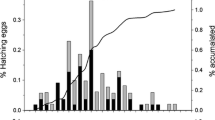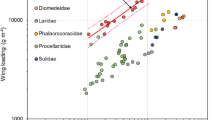Abstract
Procellariiform seabirds have a number of extreme life-history characteristics in common, in particular low reproductive rates and slow postnatal development, which are generally assumed to reflect the difficulty in acquiring energy in the marine environment. The wandering albatross (Diomedea exulans) is a sexually dimorphic species with the longest postnatal growth found in any bird, suggesting severe constraints on provisioning and possible sex-specific strategies of provisioning. We studied the provisioning behaviour and mass changes of male and female parent wandering albatross throughout the 9-months rearing period to examine how each sex adjusts its foraging effort in relation to the needs of the chicks and the seasonal changes in food availability. The study was carried out on the Crozet Islands, using an automated system recording continuously the attendance pattern of parents between March and December 1994. During the brooding period when energy requirements are highest, parents only perform trips of short duration to sea, and their body condition deteriorates. When the chick is old enough to be left alone, the parents mix short and long foraging trips. The proportion of short trips is very high until July, allowing high rate of food delivery and rapid growth, and at the same time the body condition of adults improves. From August this proportion declines until fledging in December. As a result, the feeding rate decreases from August and adult condition declines, suggesting that feeding conditions at sea are better during the first part of the chick-rearing period, i.e. in autumn and winter. Male parents perform more short trips of shorter duration and provide larger meals than females, delivering an estimated total after brooding of 110 kg of food, compared to 70–80 kg delivered by females. Meal size is inversely related to the body condition of male chicks but not to that of female chicks, suggesting that food delivery is regulated by the adults in response to the condition of the male chick. Male chicks received larger meals and more food every month than female chicks, and overall it was estimated that they receive, after brooding, 195 kg of food compared to 180 kg for the female. As a result, male chicks have a higher growth rate, attain a higher asymptotic mass, and are larger and heavier at fledging than female chicks. However, the differences are relatively small between the chicks of each sex and suggest that energy may be used differently between the sexes to maximise fitness. The results of the study suggest that provisioning effort of wandering albatrosses is adjusted by parents in relation to the availability of food, to the energetic needs of the chick and to the sex of the chick. The adult body mass is likely to play an important role in the long term for the regulation of provisioning, deficits in body mass probably providing the buffer in high power-requirement periods.
Similar content being viewed by others
Author information
Authors and Affiliations
Additional information
Accepted: 20 March 2000
Rights and permissions
About this article
Cite this article
Weimerskirch, H., Lys, P. Seasonal changes in the provisioning behaviour and mass of male and female wandering albatrosses in relation to the growth of their chick. Polar Biol 23, 733–744 (2000). https://doi.org/10.1007/s003000000144
Issue Date:
DOI: https://doi.org/10.1007/s003000000144




